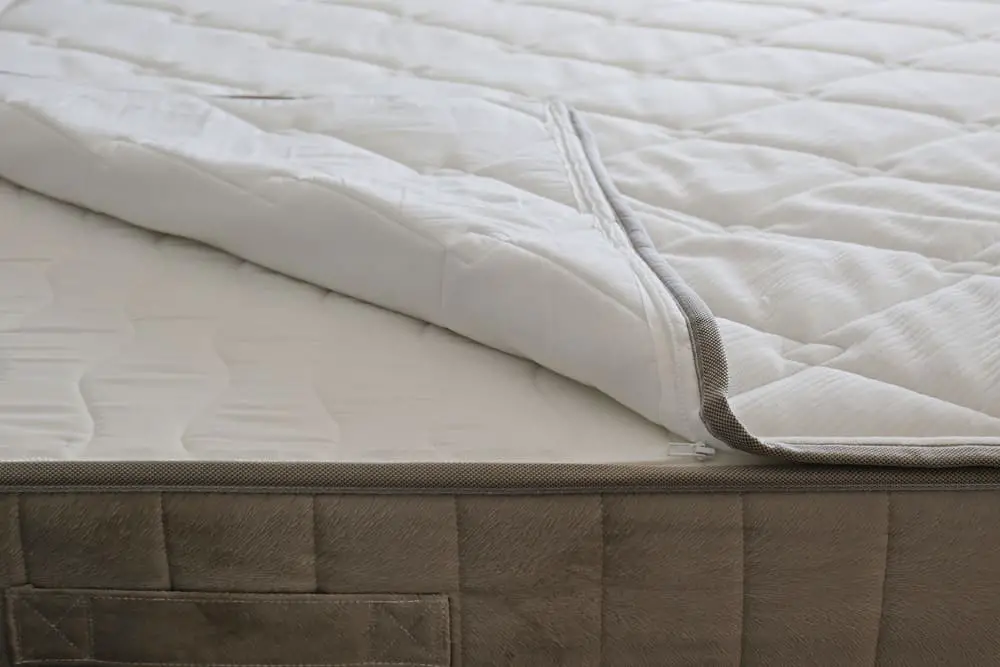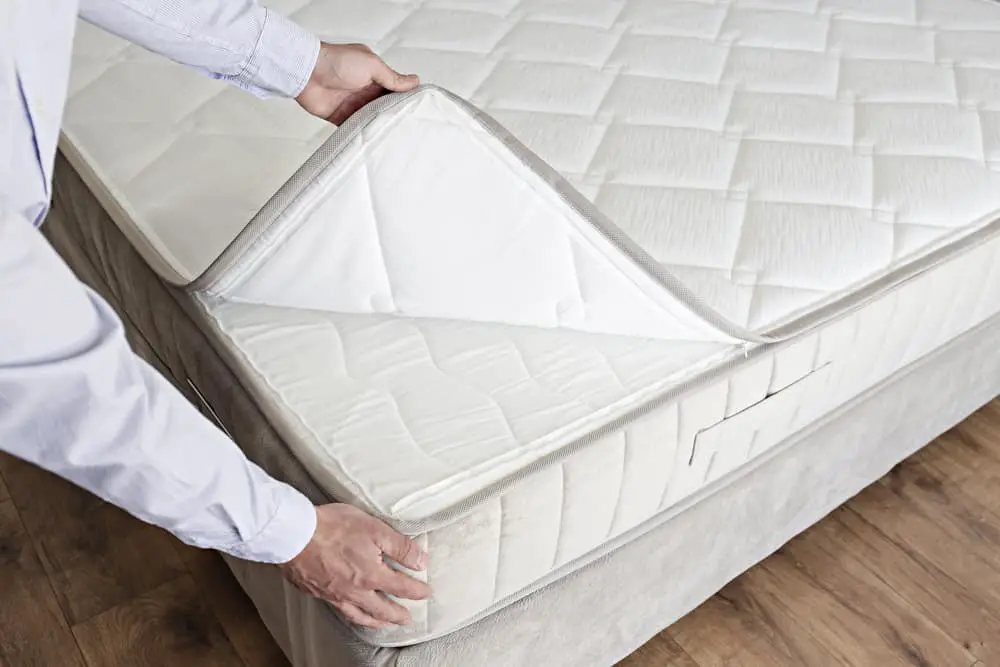Few things are as important as a good night’s sleep, and for me, nothing ruins my slumber quicker than the thought of bed bugs. If I even suspect that the mattress in an apartment rental or hotel has bed bugs, my skin already starts to itch. Even after I inspect the entire mattress, I still may not be convinced that bed bug infestations aren’t waiting around every corner.
To help give me some peace of mind and make traveling a little less anxiety-inducing, I decided to do some research on different mattress protectors. I found plastic and cotton covers and even specific bed bug mattress covers. I was surprised to find out that in their quest for human blood, bed bugs can live on plastic covers and all over your bed and bedroom; yikes!
But bed bug bites are stoppable, you can protect yourself, and plastic mattress covers can help; read on to find out how.
Can Plastic Mattress Covers Prevent Bed Bug Bites?
While we are quickest to blame the bed and mattress for bed bug bites, any surface that has bed bugs can become the culprit. Placing something between the bed bugs and you, like a plastic cover, will stop any initial bites but eventually, the bed bugs will start to live on the plastic mattress covers. While the bugs cannot go through the plastic, they will find a way around the edges which is why bed bug mattress covers close tightly and completely.
Plastic covers can be found as encasements that cover the entire mattress, like ones used for long-term storage and moving. These plastic mattress protectors can keep insects off of mattress materials and bedding while keeping it clean. Most mattresses in use will not have these kinds of furniture covers and will have a simpler top-fitting plastic mattress cover or no protection at all.
If a mattress cover made of plastic is impermeable and airtight, you can keep bed bugs from escaping while you do a room treatment, but you will be unlikely to suffocate them. Professional exterminator companies can place plastic around furniture and bedding and then suck out the air with a vacuum, but that is out of the scope of most home treatment methods.

Plastic covers on beds are hard to get in the right size to be comfortable and are designed to protect the mattress from food and other stains, not stop insects. There are better options that offer much more than adequate protection and outperform plastic coverings in keeping insects out. But there are instances where having a plastic cover can speed up the treatment time, and here are some DIY treatment tips from the experts.
A plastic cover can help keep your mattress from getting dirty, and you can use that to kill bed bugs without chemicals. While you cannot suffocate these blood-sucking insects, and starvation takes a long time, pesticide-free shortcuts are always useful. Carry your protected mattress outside in the mid-day sun for several hours and place the plastic side against a wall so the sun is hitting the top. This heat treatment will kill bed bugs fast.
If you want to increase the effects of natural or toxic pesticides, you can also use plastic to help you out. A fully enclosed mattress can be sprayed and left to fumigate. The tops of a mattress can be sprayed with a natural bed bug repellant and covered with plastic. The insects will flee away from the repellant down and out, where they can succumb to traps or residual poisons. This allows you to kill the bed bugs without sleeping directly on chemicals.
How To Use Bed Bug Mattress Encasements?
Mattress encasements offer the best protection against bed bugs as they completely enclose the mattress and cut off a bed bug’s access to food. They only work if there are no gaps, tears, or zipper breakages and the bugs are sealed in completely. Without a food source bed, bugs will die, but without heat treatment, you will want to wait 2 years before your remove or even open the encasement.
While a mattress encasement helps with bed bug bites, it cannot stop even an infestation of a small size. It will, however, help you see signs of bed bugs sooner and give you an idea of the severity of the pests. If there are bugs on the mattress already, then an encasement will trap the insects inside and prevent them from escaping and feeding. As you try to de-bed bug the rest of the room, a full cover will also stop pesticide-fleeing bugs from hiding in the deep fabric of your mattress.
A bed bug mattress zippered cover can serve as a solid step in bed bug control methods. Without adequate food bed bugs will die, but you will need more comprehensive preventative measures to avoid future infestations. When using plastic mattress encasements, find one that can cover the mattress and box spring, as most bed bugs hide in box springs since it is dryer and has more airflow than mattresses.
Mattress Protector Comparisons
There are many reasons why you may need to purchase mattress protectors. The most common reason is you just bought a new mattress and want to keep it as clean as possible since mattresses can be expensive. Any protector will prevent stains, but you will need tougher and more specific tasks.
If you are getting a mattress protector to stop bugs, you will need one that completely covers the mattress and box spring and has no tears or holes. These are usually sealed with a zipper and will keep bugs inside trapped and bugs outside away. These covers for mattresses can cost a little more and need to be a large size. They are best to use when it is needed to stop bugs fast.
Fully covering plastic covers can be useful when moving mattresses or when putting them in storage for the long term. These covers are generally thicker, water-proof, and do not breathe well. While they are good for moving, they are not nice to sleep on and wouldn’t be able to replace encasements that need to stay closed for up to 2 years.
| Protector Type | When to Use | When Not to Use |
| Fabric Mattress Cover | For normal use, stains and extra padding | For liquid stains, heavy soiling, or an insect barrier |
| Plastic Mattress Cover | Wet stains and heavy soiling are expected and to protect during storage | To prevent bed bugs and other insects from living inside your mattress |
| Bed Bug Mattress Encasement | When bed bugs are suspected or when a new mattress needs to be protected | When you need airflow or are not in danger of bed bug infestation |
| Bed Bug Box Spring Cover | When the box spring has bed bugs or a new box spring has a chance to become infested with bed bugs | When there are no bed bugs and the expense of covering the entire bed isn’t worth it |
Will Bed Bugs Starve to Death?
Unless you use expensive vacuum equipment, it will be hard to suck all the oxygen out of a plastic cover to suffocate bed bugs. They are the size of apple seeds and need far less air than us to survive. Attempting to smother bed bugs with plastic is not a useful endeavor.
The only way to stop bed bugs with encasements without the use of pesticides and chemicals is to starve them. This can be challenging since bed bugs have been examined, living between 4 and 18 months without a food source. So while you will lock bed bugs into an encasement easily, you will not be able to remove the mattress for a long time.
Can a Regular Mattress Protector Stop Bed Bug Bites?
Standard mattress covers offer no real protection again bed bugs and will still allow you to be feasted on as your sleep. The covers are not sealed, and bed bugs following the faint trail of carbon dioxide will find a way around. Once on top of the protector, bed bugs will have no problem chomping on your flesh. It also will not help bed bugs that come from other surfaces since they can just scramble on and off in the dark.
In an emergency laying, a regular water-proof mattress protector can stop bed bugs from spreading onto other fabrics. If you need to quickly put stuff down on the bed, you can try this temporary solution, but finding another place to stay is a better alternative. Outside of small stains, there is very little a plastic mattress cover can do to stop bed bugs from biting.



